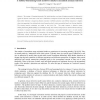3147 search results - page 14 / 630 » Statistically Hiding Sets |
MMSEC
2005
ACM
14 years 1 months ago
2005
ACM
We propose a general framework for the detection of the LSB steganography using digital media files as cover objects. The new framework exploits high-order statistics of the samp...
JMM2
2008
13 years 7 months ago
2008
To enlarge the capacity of the hidden secret information and to provide an imperceptible stego-image for human vision, a novel steganographic approach using tri-way pixel-value dif...
IMC
2009
ACM
14 years 2 months ago
2009
ACM
Fast-flux is a redirection technique used by cyber-criminals to hide the actual location of malicious servers. Its purpose is to evade identification and prevent or, at least de...
INFOSCALE
2007
ACM
13 years 9 months ago
2007
ACM
— The concept of Cumulated Anomaly (CA), which describes a new type of database anomalies, is addressed. A typical CA intrusion is that when a user who is authorized to modify da...
JOC
2010
13 years 2 months ago
2010
Abstract. A shuffle consists of a permutation and re-encryption of a set of input ciphertexts. One application of shuffles is to build mix-nets. We suggest an honest verifier zero-...

